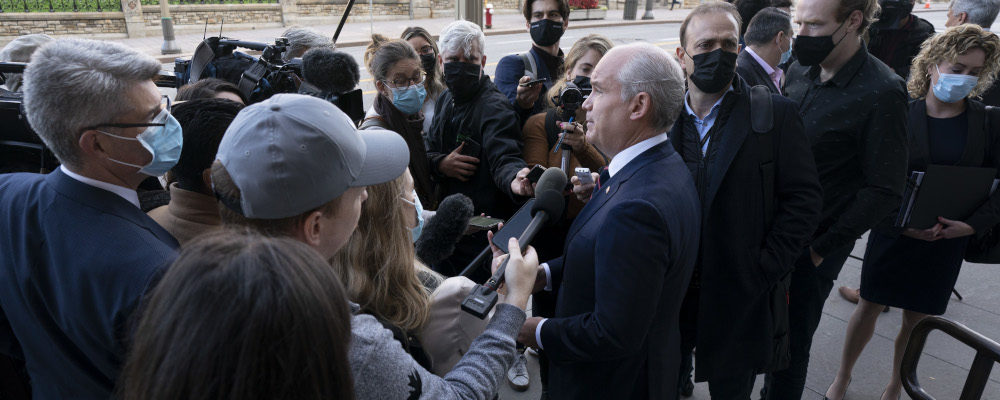The Conservative Party caucus made a little bit of history last week when they voted for the entirety of Michael Chong’s Reform Act for the first time. The bill, passed in 2014 with overwhelming support from parliamentarians, 260-17, was intended to empower parliamentary caucuses and help rebalance the relationship between parliamentary caucuses and party leaders. The act requires that members of parliament from each parliamentary caucus hold a vote at their first meeting after a general election on the four key aspects of the legislation. These are:
- Whether caucus membership is determined by caucus.
- Whether the caucus chair is chosen by the caucus.
- Whether the caucus has the power to trigger a leadership review of the party leader and remove the leader.
- Whether the caucus has the power to choose the interim party leader should there be a need for one.
So far, only the Conservative caucus and the Bloc Quebecois caucus have adopted any aspect of the Reform Act. In the 2015 and 2019 caucus votes the Conservative caucus chose to only adopt the first and second parts of the legislation. Last week the caucus decided for the first time to adopt all four aspects, including most importantly the power to trigger a leadership review. They also chose Scott Reid, who it’s fair to describe as an independently minded parliamentarian committed to the institution he serves, to be the caucus chair.
What all this points to is a caucus determined to do precisely what the Reform Act was drafted to do, namely to rebalance the relationship between caucus and the party leader. We can speculate on why the Conservative caucus might have decided to make this move in the aftermath of the recent election, but that is not the purpose of this column. Instead, it’s worth considering whether the goals of the Reform Act and empowering parliamentary caucuses is worthwhile, and if the Reform Act is actually an effective means to do this. While the Reform Act will not single handedly achieve this, it is still a big step in the right direction.
The widespread perception, both in academic scholarship and in popular and media discussions, is that Canada’s parliamentary system is characterized by the extreme centralization of power in the hands of party leaders and prime ministers. Political scientist Donald Savoie once described the prime minister as “the Sun King around whom all revolves and to whom all must pay homage.” In academic literature this trend is often referred to as “presidentialization,” where autonomous leaders govern with the help of a powerful cadre of professional staff and advisors and with minimal need for support from cabinet or caucus peers.
At the heart of this problem is a complete lack of accountability of political leaders to the parties, and more importantly the caucuses they lead. Leaders are chosen in leadership elections that supposedly represent the grassroots of the party. It may be unpopular to point this out to partisans, but these leadership elections are much less about convincing committed long term members to vote for leaders, and are instead about signing up as many people as possible from various special interest groups and communities. These members are often ephemeral and don’t remain committed to the party once a leader is selected.
Canada has a long tradition of membership driven election of leaders, it isn’t going anywhere, but we shouldn’t idealize what these leadership elections actually are. It’s also important to remember how small the segment of the population is that actually participates in these elections. Just 154,000 people voted in the Conservative leadership election that elected Erin O’Toole. A little over 5.7 million people voted for the Conservatives in the most recent election. The membership selectorate is a tiny fraction of not just the voting population but the Conservative vote base, and these leadership electorates are far from representative of the broader segment of the population that consistently vote for the party.
Just 154,000 people voted in the Conservative leadership election that elected Erin O’Toole.
Once a leader is elected, the accountability of these leaders to the people who chose them is minimal. Leadership reviews take place every few years, but beyond this there are very few direct accountability mechanisms that can actually restrain a leader or hold them to their word. This may in fact help further enhance the autonomous power of the leader as it enables them to claim personal mandates not just to lead parties, but to bend parties to their will with minimal supervision from the people who elected them. How was Erin O’Toole able to run a leadership campaign as a true blue and then pivot to something else, including writing a platform that seems to have taken many in the party by surprise? Because he can. Once he was elected leader he had the power to do so and no one could really stop him.
But more importantly, party leaders are first and foremost parliamentary leaders. Canada’s Westminster parliamentary system is one in which party leaders lead caucuses in parliament, whether in government or opposition. Party government is now at the core of responsible government in virtually all representative democracies, and the central institution here is parliament. Responsible government as it has evolved in Canada is one in which executive power is now in reality wielded by a cabinet and prime minister who reside in and are directly accountable to parliament. Our form of government is worth celebrating and defending precisely because it allows for both efficient government that isn’t gridlocked and a direct accountability mechanism whereby the government has to answer to and retain the confidence of the house to wield power.
But this requires a parliament, and caucuses, who actually understand their crucial role in ensuring accountable and responsible government. The academic and layperson perception of parliament is one in which party discipline is so strong that in majorities, prime ministers wield near absolute power, and caucuses and cabinets are nothing but glorified focus groups. This is not the consensus view, and Ian Brodie’s excellent recent book At the Centre of Government offers a compelling counterargument against this common view. One key part of his account of how government in Canada actually works is that caucuses especially are not just focus groups, and they do play an important role behind closed doors in guiding and restraining leaders.
Party discipline is undoubtedly strong in Canada, but we hear news and gossip all the times about grumblings in caucuses, and any MP will tell you that caucuses are places where MPs can speak out. Caucus meetings are black boxes to the rest of us and this caucus confidentiality is a key to actually ensuring open and frank discussions can take place. But caucus playing an active role in restraining and guiding party leaders is vital to ensure our Westminster parliamentary system works properly. Caucus power is something we should be seeking to strengthen.
We can disagree over the extent to which party leaders act as autonomous dictators and the extent to which caucuses do actually restrain leaders. But what we should be able to agree on is that caucus power and independence is vital to our democracy and that Canadian democracy would benefit from stronger caucuses. This means giving MPs more independence from their parties so that caucuses are both more robust, and parliament more broadly is able to hold the government responsible.
Which brings us back to the Reform Act. Caucus control over its own membership and electing its own chair are both good. Though as long as party leaders can veto nominations by refusing to sign nomination papers, this caucus power still comes with an asterix. However, caucus retaining this formal control still sends an important signal to leaders and should at the very least make them think twice before unilaterally dumping MPs if the caucus disagrees. This is a good first step in this rebalancing process.
But the most important step is the one that the Conservative caucus made moves towards using the Reform Act—leadership selection. The caucus doesn’t now have power to choose a leader, but it does now have a formal mechanism by which it can impeach a leader if it feels the need to do so. This is important. Serious accountability requires formal mechanisms that can be used when necessary to actually hold leaders accountable.
A leader that completely loses the confidence of their caucus will likely not be able to hold on for long (ask plenty of former Alberta premiers or Patrick Brown about this) but the point of a formal mechanism like this is precisely that it forces an adjustment from leadership precisely so that they govern or lead in a way that brings the caucus in and prevents top down autocracy. Talk can be backed up with action. This changes the nature of the relationship between a caucus and a leader and helps move the dial towards the rebalancing that the Reform Act aims at.
Leadership elections probably aren’t going anywhere, and a caucus voting to remove a leader might hypothetically lead to a scenario where the removed leader in question manages to win a subsequent leadership election and come back with an emboldened independent mandate. Something similar to this happened to Jeremy Corbyn in 2016, who was elected leader of the Labour Party in Britain in 2015 as an outsider and populist candidate and had an extremely sour relationship with the parliamentary Labour caucus. The caucus eventually voted 172-40 against Corbyn in a non-confidence vote, but Corbyn went on to subsequently win a leadership review voted on by party members by a slightly bigger margin than he had originally won the leadership on. Corbyn came back emboldened and went on to perform surprisingly well in the UK general election in 2017 when he knocked the Conservatives down to a minority despite starting the election some 20 points down in the polls.
A caucus in Canada is unlikely to use this power to remove a leader anytime soon, but a formal mechanism that ensures a leader has to retain the confidence of the caucus they lead is a vital step in rebalancing the one-sided relationship between caucuses and leaders. A caucus adopting the entirety of the Reform Act is a big step in the right direction in helping to revitalize and strengthen Canadian parliamentary democracy.
Formal mechanisms like those set out in the Reform Act are important precisely because they provide actual mechanisms by which caucus can assert independence and MPs can hold their leaders accountable. But the key to rebalancing this relationship long term is that these formal mechanisms help to over time reshape the political culture so that new norms and expectations can emerge that empower caucuses and bring leaders into a more accountable and collaborative relationship with the caucuses they lead. This will help improve both the quality and the robustness of our democracy, and while the Reform Act will not solve these problems single handedly, it is still a valuable tool in helping to rebalance this relationship.




